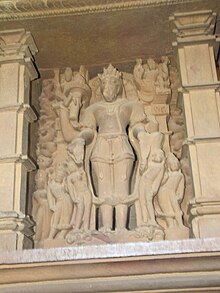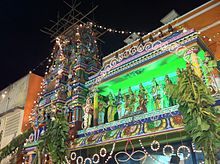Hayagriva
This articleneeds additional citations forverification.(December 2022) |
| Hayagriva | |
|---|---|
God of Wisdom[1] | |
 Painting of Hayagriva,Nataraja Temple, Chidambaram | |
| Other names | Hayashirsha |
| Sanskrittransliteration | Hayagrīva |
| Affiliation | Vaishnavism |
| Abode | Vaikuntha |
| Mantra | jñānānandamayaṃ devaṃ nirmala sphaṭikākṛtim / ādhāraṃ sarva viddyānāṃ hayagrīvaṃ upāsmahe // |
| Weapon | Sudarshana Chakra Panchajanya |
| Consort | Lakshmi |
| Part ofa serieson |
| Vaishnavism |
|---|
 |
Hayagriva(Sanskrit:हयग्रीवIASThayagrīva,lit. 'horse-necked one') is aHindudeity, the horse-headed avatar ofVishnu.The purpose of this incarnation was to slay adanavaalso named Hayagriva (A descendant ofKashyapaand Danu), who had the neck of a horse and the body of a human.[2]
Iconography
[edit]
Hayagriva is anavataraof the godVishnu.[3]He is worshipped as the god ofknowledgeandwisdom,with a human body and a horse's head, brilliantwhite in color,with white garments and seated on a whitelotus.Symbolically, the story represents the triumph of pure knowledge, guided by the hand of Divinity, over the demonic forces of passion and darkness.[4]
Vedanta Desika'sdhyāna-śloka(meditative verse) on Hayagriva typifies this deity's depiction in Hindu iconography:
He hasfour hands,with one in the mode of bestowing knowledge; another holds books of wisdom, and the other two hold theConchandDiscus.His beauty, like fresh cut crystal, is an auspicious brilliance that never decays. May this Lord of speech who showers such cooling rays of grace on me be forever manifest in my heart![5]
In several other sources he is a white horse who pulls the sun into the sky every morning. In others such as the great epic Taraka-battle where the demigods are fallen on and attacked by the Danava's [demons], Vishnu appears as a great ferocious warrior called Hayagriva when he comes to their aid. It says: "Hayagriva appears in his chariot, drawn by 1,000 powerful steeds, crushing the enemies of the gods beneath him!"[This quote needs a citation]There are many other references to Hayagriva throughout the Mahabharata.
It is said that Vishnu comes from battle as a conqueror in the magnificent mystic form of the great and terrible Hayagriva:
The great Hayagriva having been praised in this way by the different saints and ascetics, assumes a great white horses head. The verda’s [mantras] made up his shape, his body built of all the great demigods; in the middle of his head wasShiva,in his heart was Brahmā; the rays of sun (Marichi) were his mane, the sun and moon his eyes; the Vasus and Sadhyas were his legs, in all his bones were the demigods.Agni[Ka-ten; god of fire] was his tongue, the goddessSatyahis speech, while his knees were formed by theMarutsandVaruna.Having assumed this form, an awesome wonder to behold to the demigods, he vanquished the asura, and cast them down, with eyes that were red with anger.[This quote needs a citation]
Invariably, Hayagriva is depicted seated, most often with his right hand either blessing the supplicant or in thevyākhyā mudrāpose of teaching. The right hand also usually holds aakṣa-mālā(rosary), indicating his identification with meditative knowledge. His left holds a book, indicating his role as a teacher. His face is always serene and peaceful, if not smiling. Unlike his Buddhist counterpart, there is no hint of a fearsome side in the Hindu description of this deity.
Hayagriva is sometimes worshiped in a solitary pose of meditation, as inThiruvanthipuram Devanathasvami Temple.This form is known as Yoga-Hayagriva. However, he is most commonly worshipped along with his consort Lakshmi and is known as Lakshmi-Hayagriva. Hayagriva in this form is the presiding deity ofMysuru'sParakala Matha,a significantSri Vaishnavismmonastic institution.[6]
Legend
[edit]According to legend, during the period of creation, two demons Madhu and kaitabha stole theVedasfromBrahma,and Vishnu assumed the Hayagriva form to recover them. Yet another legend has it that during the creation, Vishnu compiled the Vedas in the Hayagriva form.
Hayagriva is listed as one of the ten incarnations of Vishnu in canto 10, chapter 40 of theBhagavata Purana.In the text,Akrura's prayer contains Hayagriva's name when he had a vision while bathing in theYamuna.[7]
TheMahabharataalso features the legend of Hayagriva:[citation needed]
Having compassed the destruction of the two Asuras and restored the Vedas to Brahma, the Supreme Being dispelled the grief of Brahma. Aided then by Hari and assisted by the Vedas, Brahma created all the worlds with their mobile and immobile creatures. After this, Hari, granting unto the Grandsire intelligence of the foremost order relating to the Creation, disappeared there and then for going to the place he had come from. It was thus that Narayana, having assumed the form equipped with the horse-head, slew the two Danavas Madhu and Kaitabha (and disappeared from the sight of Brahma).
— Mahabharata,Book 12, Chapter 348
Worship
[edit]| Part ofa serieson |
| Vaishnavism |
|---|
 |
Origins about the worship of Hayagriva have been researched, some of the early evidences dates back to 2,000 BCE,[8]when people worshipped the horse for its speed, strength, intelligence.[9]Hayagriva is one of the prominent deities inVaikhanasas,Sri Vaishnavism,and theDvaita Vedantatraditions. His blessings are sought when beginning study of both sacred and secular subjects. Special worship is conducted on the day of the full moon in August (Shravana-Paurnami) (the day of his incarnation) and onMahanavami,the ninth day of theNavaratrifestival.
A verse originally from thePancaratra Agama,but is now popularly prefixed to theHayagriva Stotramof the 13th-century poet-philosopherVedanta Desikais popular among devotees of Hayagriva:
jñānānandamayaṃ devaṃ nirmalasphaṭikākṛtiṃ
ādhāraṃ sarvavidyānāṃ hayagrīvaṃ upāsmahe
Acoording to legend, aDvaitaphilosopher namedVadirajatirthais regarded to have offer cooked horse gram (kollu) to Hayagriva, and the deity is regarded to have appeared to consume his offerings.[10]Vadirajatirtha would recite the followingshloka:
naḥ hayagrīvat paraṃ aṣṭi maṅgalam
naḥ hayagrīvat paraṃ aṣṭi pāvanam
naḥ hayagrīvat paraṃ aṣṭi daivatam
naḥ hayagrīvam praṇipatya siddhati
Hayagriva is also amongst the deities present at theRanganathaswamy Temple, Srirangam.
Temples
[edit]
Assam
[edit]- Hayagriv Madhav Dolat Hajo, Assam
Tamil Nadu
[edit]Most of the major Vishnu temples in Tamil Nadu have a separate shrine for Lord Hayagriva.[citation needed]
- Sri Lakshmi Hayagriva Temple, Thiruvaheendrapuram, Cuddalore, Tamil Nadu
- Sri Hayagreevar Temple, adjacent to Sri Koodal Alagar Perumal Koil, Madurai
- Sri Hayagreevar Swamy, Sri Chidambara Vinayagar Thirukoil, A. Vellalapatti (7 km from Alagarkoil or Melur), Madurai.
- Lakshmi hayagrivar temple in chithambara Nagar, near Ganapathi mill, at Tirunelveli
- Sri Lakshmi Hayagreevar perumal, at Sri Kothandaramaswamy Devasthanam, Perumudivakkam, near Kannigaipair (Chennai - Periyapalayam Highway), Thiruvallur District - 601103.
- Yoga Hayagreevar and Gnana Saraswathi in Vaitheeswaran Koil, Munusamy St, Amrithammal Colony, Perambur, Chennai - 600 011
- Chettypunyam Hayagriva Temple, nearChengalpattu,Tamil Nadu
- Sri Lakshmi Hayagriva Temple, Nanganallur, Chennai, Tamil Nadu.
- Lord Hayagriva Sannidhi in Thooppul Vilakoli (Deepa Prakasar) Perumal Koil in Kanchipuram.
- Vedanta Deshika Alayam, Mylapore
- Lakshmi Hayagreeva Temple, Moovar Nagar, Pozhichalur, Chennai-74
Pondicherry
[edit]
- Sri Lakshmi Hayagriva Temple in Sri Ramakrishna Nagar, Muthialpet, Pondicherry
Karnataka
[edit]- Parakala Mutt,Mysuru - The Hayagriva idol handed down from Vedanta Desika

- Hayagreeva temple, Satyagala kollegala taluk chamarajanagar district karnataka
- Sri Lakshmi Hayagriva Temple, Tank Bund Road, Gandhi Nagar, Bangalore, Karnataka
- SodheMutt, Sirsi, Karnataka
Andhra Pradesh
[edit]- Tirumala Hayagriva temple on North Mada street of Srinivasa/ Balaji Temple,Tirumala,Tirupati,Andhra Pradesh
- Sri Lakshmi Hayagriva Swami Temple,Machilipatnam,Andhra Pradesh
- Sri Lakshmi Hayagriva Temple,Thotlakonda,Visakhapatnam,Andhra Pradesh
- Sri Lakshmi Hayagriva temple, siddhashramam, Narasimhakonda, near jonnawada, Nellore, Andhra Pradesh
- Shri Lakshmi Hayagriva Swamy, installed in birthplace of Kethanda patti Swamy at Lakshmipuram, near Kuppam, Chittoor District, Andhra Pradesh.
- Sri Lakshmi Hayagriva temple, MF Road, Hindupur Mandal, Anantapur
Telangana
[edit]- Hayagriva Swami Temple Beechupalli Telanganaa
- Shri Lakshmi Hayagreeva Swamy Temple, Vangapalli Road, Yadagirigutta, Yadadri District, Telangana, 508115
Influence on other cultures
[edit]In the 2015 documentary series,The Creatures of Philippine Mythology,the spread of Hinduism and the imagery of Hayagriva is tracked throughSoutheast Asia.It is speculated that Hayagriva influenced the present imagery of the horse-headedPhilippine mythologicalspirit, theTikbalang.[11]
An extinct genus of basal neornithischian dinosaur known fromMongoliahas been namedHaya griva.This name refers to the elongate horse-like skull ofHayaand the appearance of this deity in the Buddhist art of Mongolia.[12]
Demon Hayagriva
[edit]The demon Hayagriva was a son ofKashyapaand Danu. He became the first ruler of theDanavas.In Hindu texts, it is stated that whenVishnuhad created theVedasand given them toBrahma,Shivahad decided to wipe out all of humanity except forManuand his wife, as the rest of humanity was too corrupt to obtain the Vedas. When Hayagariva learnt that humans would be greater than the Danavas, he set out to stop the humans from obtaining the Vedas. Hayagriva visited theSatyalokawhen Brahma was absent, and turned into a horse to get the attention of the Vedas (who were in the form of 4 children). He asked them why Brahma has brought them to his realm rather than taking them to humanity. After hearing their tale, Hayagriva laughed and deceived them regarding the intentions of Brahma, stating that the deity wished to keep them for himself. The Vedas were then subsequently imprisoned by the demon. Soon,Vishnuassumed hisMatsya avatarand instructed Manu the manner by which he should survive the oncoming flood thatShivawould shortly send to vanquish all evil.Vishnuthen slew Hayagriva in hisMatsyaform and freed the Vedas to bequeath them to Manu after the passage of the flood.[13][14]
See also
[edit]- Hayagriva (Buddhism)
- Haya(dinosaur)
- Keshi (demon)– Horse-demon killed by Krishna, an avatar of the god Vishnu
References
[edit]- ^Ninan, M. M. (23 June 2008).The Development of Hinduism.Madathil Mammen Ninan.ISBN9781438228204.
- ^"The Hare Krsnas - Battles of Vishnu Avatars - Ajnana / Hayagriva".harekrsna.Retrieved15 November2021.
- ^Swami Parmeshwaranand (1 January 2001).Encyclopaedic Dictionary of Puranas.Sarup & Sons. pp. 632–.ISBN978-81-7625-226-3.Retrieved21 August2013.
- ^Santhanam, Kanakavalli (9 January 2020)."Hayagriva – The Bestower of Knowledge".Fundamatics.Retrieved15 November2021.
- ^"Vedanta Desika's Hayagriva Stotram (Ramanuja.org/Journal)".ramanuja.org.Retrieved11 January2023.
- ^"Lakshmi Hayagrivar Temple: Lakshmi Hayagrivar Temple Details | Lakshmi Hayagrivar - Muthialpettai | Tamilnadu Temple | லட்சுமி ஹயக்ரீவர்".Dinamalar.Retrieved15 November2021.
- ^"Srimad Bhagavatam: Canto 10 - Chapter 40".bhagavata.org.Retrieved15 November2021.
- ^T. Volker (1950).The Animal in Far Eastern Art: And Especially in the Art of the Japanese Netzsuke, with References to Chinese Origins, Traditions, Legends, and Art.BRILL. p. 102.
- ^Mārg̲, Volume 43.p. 77.Originally from = University of Michigan
- ^Śrī Vadiraja's lifehistory
- ^Clark, Jordan "Tikbalang: The Horse Demon" Episode 01,Creatures Of Philippine Mythology(2015)https:// youtube /watch?v=gRUSBSJ39KY
- ^Makovicky, Peter J.; Kilbourne, Brandon M.; Sadleir, Rudyard W.; Norell, Mark A. (9 May 2011)."A new basal ornithopod (Dinosauria, Ornithischia) from the Late Cretaceous of Mongolia".Journal of Vertebrate Paleontology.31(3): 626–640.Bibcode:2011JVPal..31..626M.doi:10.1080/02724634.2011.557114.ISSN0272-4634.S2CID86257644.
- ^corvusfugit (13 August 2017)."2.2 mya: Matsya and the Asura Hayagriva".Retrieved15 November2021.
- ^"Who was Hayagriva, why did he steal the four Vedas and how did Lord Vishnu eliminate him?".timesnownews.21 May 2020.Retrieved15 November2021.
Bibliography
[edit]- Dictionary of Hindu Lore and Legend(ISBN0-500-51088-1) by Anna L. Dallapiccola
- Prof. D. Sridhara Babu (1990).HAYAGRIVA - The Horse-headed Deity in Indian Culture.Sri Venkateshwara University - Oriental Research Institute, Tirupati.
- Veṅkaṭanātha (1978).Sri Hayagreeva Stotram of Vedanta Desika.Visishtadvaitha Pracharini Sabha.
- Devi Bhagawatam
External links
[edit] Media related toHayagriva (Hinduism)at Wikimedia Commons
Media related toHayagriva (Hinduism)at Wikimedia Commons


